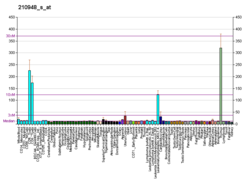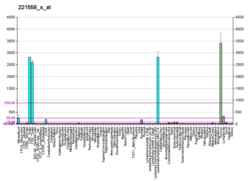Protein-coding gene in the species Homo sapiens
Lymphoid enhancer-binding factor 1 (LEF1 ) is a protein that in humans is encoded by the LEF1 gene .[5] TCF/LEF ) family.
Function [ edit ] Lymphoid enhancer-binding factor-1 (LEF1) is a 48-kD nuclear protein that is expressed in pre-B and T cells . It binds to a functionally important site in the T-cell receptor-alpha (TCRA ) enhancer and confers maximal enhancer activity. LEF1 belongs to a family of regulatory proteins that share homology with high mobility group protein-1 (HMG1 ).[6]
Clinical significance [ edit ] LEF1 is highly overexpressed and associated with disease progression and poor prognosis in B-cell chronic lymphocytic leukemia [7] colorectal cancer .[8] [9]
Interactions [ edit ] Lymphoid enhancer-binding factor 1 has been shown to interact with:
References [ edit ]
^ a b c GRCh38: Ensembl release 89: ENSG00000138795 – Ensembl , May 2017^ a b c GRCm38: Ensembl release 89: ENSMUSG00000027985 – Ensembl , May 2017^ "Human PubMed Reference:" . National Center for Biotechnology Information, U.S. National Library of Medicine .^ "Mouse PubMed Reference:" . National Center for Biotechnology Information, U.S. National Library of Medicine .^ Milatovich A, Travis A, Grosschedl R, Francke U (December 1991). "Gene for lymphoid enhancer-binding factor 1 (LEF1) mapped to human chromosome 4 (q23-q25) and mouse chromosome 3 near Egf" . Genomics . 11 (4): 1040–1048. doi :10.1016/0888-7543(91)90030-I PMID 1783375 . ^ "Entrez Gene: LEF1 lymphoid enhancer-binding factor 1" .^ Erdfelder F, Hertweck M, Filipovich A, Uhrmacher S, Kreuzer KA (January 2010). "High lymphoid enhancer-binding factor-1 expression is associated with disease progression and poor prognosis in chronic lymphocytic leukemia" . Hematology Reports . 2 (1): e3. doi :10.4081/hr.2010.e3 . PMC 3222268 PMID 22184516 . ^ Eskandari E, Mahjoubi F, Motalebzadeh J (December 2018). "An integrated study on TFs and miRNAs in colorectal cancer metastasis and evaluation of three co-regulated candidate genes as prognostic markers". Gene . 679 : 150–159. doi :10.1016/j.gene.2018.09.003 . PMID 30193961 . S2CID 52172531 . ^ Gandhirajan RK, Staib PA, Minke K, Gehrke I, Plickert G, Schlösser A, et al. (April 2010). "Small molecule inhibitors of Wnt/beta-catenin/lef-1 signaling induces apoptosis in chronic lymphocytic leukemia cells in vitro and in vivo" . Neoplasia . 12 (4): 326–335. doi :10.1593/neo.91972 . PMC 2847740 PMID 20360943 . ^ Boras K, Hamel PA (January 2002). "Alx4 binding to LEF-1 regulates N-CAM promoter activity" . The Journal of Biological Chemistry . 277 (2): 1120–1127. doi :10.1074/jbc.M109912200 PMID 11696550 . ^ Lutterbach B, Westendorf JJ, Linggi B, Isaac S, Seto E, Hiebert SW (January 2000). "A mechanism of repression by acute myeloid leukemia-1, the target of multiple chromosomal translocations in acute leukemia" . The Journal of Biological Chemistry . 275 (1): 651–656. doi :10.1074/jbc.275.1.651 PMID 10617663 . ^ Edlund S, Lee SY, Grimsby S, Zhang S, Aspenström P, Heldin CH, Landström M (February 2005). "Interaction between Smad7 and beta-catenin: importance for transforming growth factor beta-induced apoptosis" . Molecular and Cellular Biology . 25 (4): 1475–1488. doi :10.1128/MCB.25.4.1475-1488.2005 . PMC 548008 PMID 15684397 . ^ Grueneberg DA, Pablo L, Hu KQ, August P, Weng Z, Papkoff J (June 2003). "A functional screen in human cells identifies UBF2 as an RNA polymerase II transcription factor that enhances the beta-catenin signaling pathway" . Molecular and Cellular Biology . 23 (11): 3936–3950. doi :10.1128/MCB.23.11.3936-3950.2003 . PMC 155208 PMID 12748295 . ^ Behrens J, von Kries JP, Kühl M, Bruhn L, Wedlich D, Grosschedl R, Birchmeier W (August 1996). "Functional interaction of beta-catenin with the transcription factor LEF-1". Nature . 382 (6592): 638–642. Bibcode :1996Natur.382..638B . doi :10.1038/382638a0 . PMID 8757136 . S2CID 4369341 . ^ a b c Labbé E, Letamendia A, Attisano L (July 2000). "Association of Smads with lymphoid enhancer binding factor 1/T cell-specific factor mediates cooperative signaling by the transforming growth factor-beta and wnt pathways" . Proceedings of the National Academy of Sciences of the United States of America . 97 (15): 8358–8363. Bibcode :2000PNAS...97.8358L . doi :10.1073/pnas.150152697 PMC 26952 PMID 10890911 . ^ Barolo S, Posakony JW (May 2002). "Three habits of highly effective signaling pathways: principles of transcriptional control by developmental cell signaling" . Genes & Development . 16 (10). Cold Spring Harbor Laboratory Press & The Genetics Society : 1167–1181. doi :10.1101/gad.976502 PMID 12023297 . S2CID 14376483 . p. 1170: In ... zebrafish, reporter transgenes containing the TOPFLASH promoter are expressed in certain Wnt-responsive cell types (...Dorsky et al. 2002). ^ Hecht A, Stemmler MP (February 2003). "Identification of a promoter-specific transcriptional activation domain at the C terminus of the Wnt effector protein T-cell factor 4" . The Journal of Biological Chemistry . 278 (6): 3776–3785. doi :10.1074/jbc.M210081200 PMID 12446687 . ^ Yasumoto K, Takeda K, Saito H, Watanabe K, Takahashi K, Shibahara S (June 2002). "Microphthalmia-associated transcription factor interacts with LEF-1, a mediator of Wnt signaling" . The EMBO Journal . 21 (11): 2703–2714. doi :10.1093/emboj/21.11.2703 . PMC 126018 PMID 12032083 . ^ Sachdev S, Bruhn L, Sieber H, Pichler A, Melchior F, Grosschedl R (December 2001). "PIASy, a nuclear matrix-associated SUMO E3 ligase, represses LEF1 activity by sequestration into nuclear bodies" . Genes & Development . 15 (23): 3088–3103. doi :10.1101/gad.944801 . PMC 312834 PMID 11731474 .
Further reading [ edit ]
Waterman ML (2004). "Lymphoid enhancer factor/T cell factor expression in colorectal cancer" . Cancer and Metastasis Reviews . 23 (1–2): 41–52. doi :10.1023/A:1025858928620 . PMID 15000148 . S2CID 20996511 . Skokowa J, Welte K (June 2007). "LEF-1 is a decisive transcription factor in neutrophil granulopoiesis". Annals of the New York Academy of Sciences . 1106 (1): 143–151. Bibcode :2007NYASA1106..143S . doi :10.1196/annals.1392.012 . PMID 17360796 . S2CID 30579011 . Travis A, Amsterdam A, Belanger C, Grosschedl R (May 1991). "LEF-1, a gene encoding a lymphoid-specific protein with an HMG domain, regulates T-cell receptor alpha enhancer function [corrected]" . Genes & Development . 5 (5): 880–894. doi :10.1101/gad.5.5.880 PMID 1827423 . van de Wetering M, Oosterwegel M, Dooijes D, Clevers H (January 1991). "Identification and cloning of TCF-1, a T lymphocyte-specific transcription factor containing a sequence-specific HMG box" . The EMBO Journal . 10 (1): 123–132. doi :10.1002/j.1460-2075.1991.tb07928.x . PMC 452620 PMID 1989880 . Waterman ML, Fischer WH, Jones KA (April 1991). "A thymus-specific member of the HMG protein family regulates the human T cell receptor C alpha enhancer" . Genes & Development . 5 (4): 656–669. doi :10.1101/gad.5.4.656 PMID 2010090 . Zhou P, Byrne C, Jacobs J, Fuchs E (March 1995). "Lymphoid enhancer factor 1 directs hair follicle patterning and epithelial cell fate" . Genes & Development . 9 (6): 700–713. doi :10.1101/gad.9.6.700 PMID 7537238 . Maruyama K, Sugano S (January 1994). "Oligo-capping: a simple method to replace the cap structure of eukaryotic mRNAs with oligoribonucleotides". Gene . 138 (1–2): 171–174. doi :10.1016/0378-1119(94)90802-8 . PMID 8125298 . Prieve MG, Guttridge KL, Munguia JE, Waterman ML (March 1996). "The nuclear localization signal of lymphoid enhancer factor-1 is recognized by two differentially expressed Srp1-nuclear localization sequence receptor proteins" . The Journal of Biological Chemistry . 271 (13): 7654–7658. doi :10.1074/jbc.271.13.7654 PMID 8631802 . Behrens J, von Kries JP, Kühl M, Bruhn L, Wedlich D, Grosschedl R, Birchmeier W (August 1996). "Functional interaction of beta-catenin with the transcription factor LEF-1". Nature . 382 (6592): 638–642. Bibcode :1996Natur.382..638B . doi :10.1038/382638a0 . PMID 8757136 . S2CID 4369341 . Bagga R, Emerson BM (March 1997). "An HMG I/Y-containing repressor complex and supercoiled DNA topology are critical for long-range enhancer-dependent transcription in vitro" . Genes & Development . 11 (5): 629–639. doi :10.1101/gad.11.5.629 PMID 9119227 . Bruhn L, Munnerlyn A, Grosschedl R (March 1997). "ALY, a context-dependent coactivator of LEF-1 and AML-1, is required for TCRalpha enhancer function" . Genes & Development . 11 (5): 640–653. doi :10.1101/gad.11.5.640 PMID 9119228 . Brannon M, Gomperts M, Sumoy L, Moon RT, Kimelman D (September 1997). "A beta-catenin/XTcf-3 complex binds to the siamois promoter to regulate dorsal axis specification in Xenopus" . Genes & Development . 11 (18): 2359–2370. doi :10.1101/gad.11.18.2359 . PMC 316518 PMID 9308964 . Suzuki Y, Yoshitomo-Nakagawa K, Maruyama K, Suyama A, Sugano S (October 1997). "Construction and characterization of a full length-enriched and a 5'-end-enriched cDNA library". Gene . 200 (1–2): 149–156. doi :10.1016/S0378-1119(97)00411-3 . PMID 9373149 . Korinek V, Barker N, Willert K, Molenaar M, Roose J, Wagenaar G, et al. (March 1998). "Two members of the Tcf family implicated in Wnt/beta-catenin signaling during embryogenesis in the mouse" . Molecular and Cellular Biology . 18 (3): 1248–1256. doi :10.1128/MCB.18.3.1248 . PMC 108837 PMID 9488439 . Prieve MG, Guttridge KL, Munguia J, Waterman ML (August 1998). "Differential importin-alpha recognition and nuclear transport by nuclear localization signals within the high-mobility-group DNA binding domains of lymphoid enhancer factor 1 and T-cell factor 1" . Molecular and Cellular Biology . 18 (8): 4819–4832. doi :10.1128/MCB.18.8.4819 . PMC 109067 PMID 9671491 . Levanon D, Goldstein RE, Bernstein Y, Tang H, Goldenberg D, Stifani S, et al. (September 1998). "Transcriptional repression by AML1 and LEF-1 is mediated by the TLE/Groucho corepressors" . Proceedings of the National Academy of Sciences of the United States of America . 95 (20): 11590–11595. Bibcode :1998PNAS...9511590L . doi :10.1073/pnas.95.20.11590 PMC 21685 PMID 9751710 . Hovanes K, Li TW, Waterman ML (May 2000). "The human LEF-1 gene contains a promoter preferentially active in lymphocytes and encodes multiple isoforms derived from alternative splicing" . Nucleic Acids Research . 28 (9): 1994–2003. doi :10.1093/nar/28.9.1994 . PMC 103301 PMID 10756202 . Labbé E, Letamendia A, Attisano L (July 2000). "Association of Smads with lymphoid enhancer binding factor 1/T cell-specific factor mediates cooperative signaling by the transforming growth factor-beta and wnt pathways" . Proceedings of the National Academy of Sciences of the United States of America . 97 (15): 8358–8363. Bibcode :2000PNAS...97.8358L . doi :10.1073/pnas.150152697 PMC 26952 PMID 10890911 . Brantjes H, Roose J, van De Wetering M, Clevers H (April 2001). "All Tcf HMG box transcription factors interact with Groucho-related co-repressors" . Nucleic Acids Research . 29 (7): 1410–1419. doi :10.1093/nar/29.7.1410 . PMC 31284 PMID 11266540 .
External links [ edit ] This article incorporates text from the United States National Library of Medicine , which is in the public domain .
(1) Basic domains
(1.1) Basic leucine zipper (bZIP )(1.2) Basic helix-loop-helix (bHLH )
Group A Group B Group CPAS Group D Group E Group F
(1.3) bHLH-ZIP (1.4) NF-1 (1.5) RF-X (1.6) Basic helix-span-helix (bHSH)
(2) Zinc finger DNA-binding domains
(2.1) Nuclear receptor (Cys4 )
subfamily 1 subfamily 2 subfamily 3 subfamily 4 subfamily 5 subfamily 6 subfamily 0
(2.2) Other Cys4 (2.3) Cys2 His2 (2.4) Cys6 (2.5) Alternating composition (2.6) WRKY
(4) β-Scaffold factors with minor groove contacts
(0) Other transcription factors









Well, that’s interesting to know that Psilotum nudum are known as whisk ferns. Psilotum nudum is the commoner species of the two. While the P. flaccidum is a rare species and is found in the tropical islands. Both the species are usually epiphytic in habit and grow upon tree ferns. These species may also be terrestrial and grow in humus or in the crevices of the rocks.
View the detailed Guide of Psilotum nudum: Detailed Study Of Psilotum Nudum (Whisk Fern), Classification, Anatomy, Reproduction